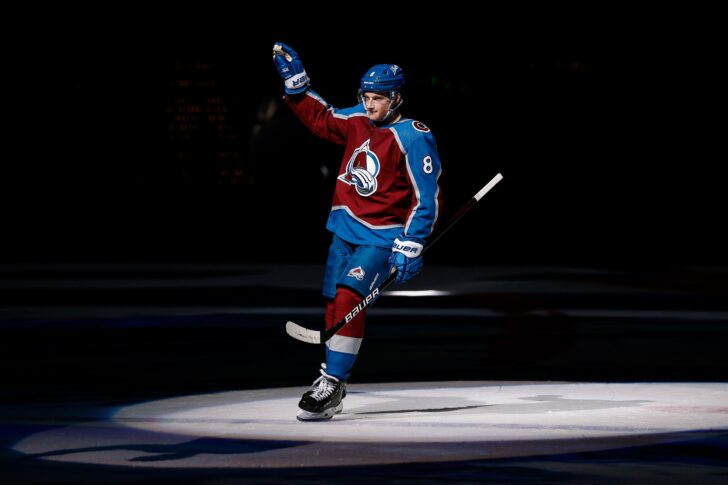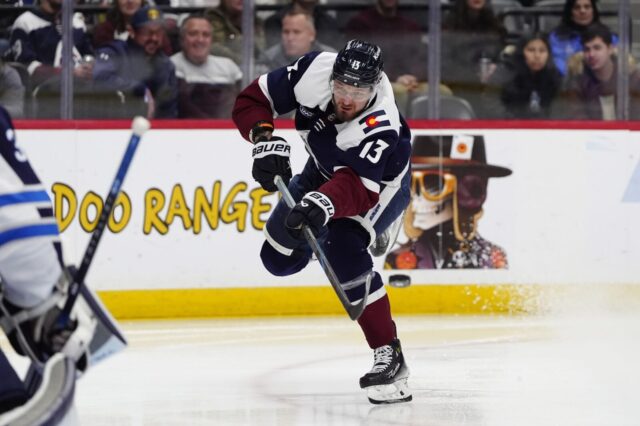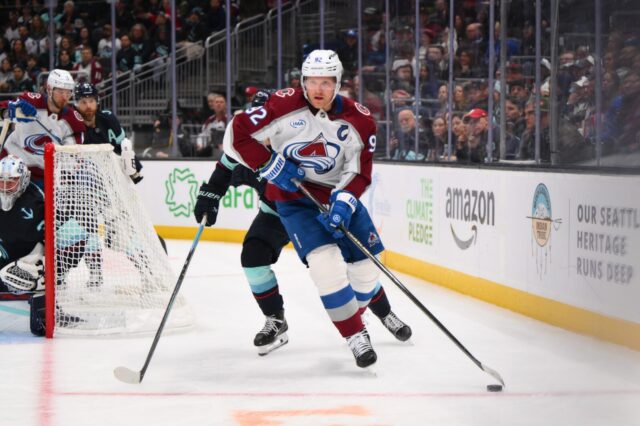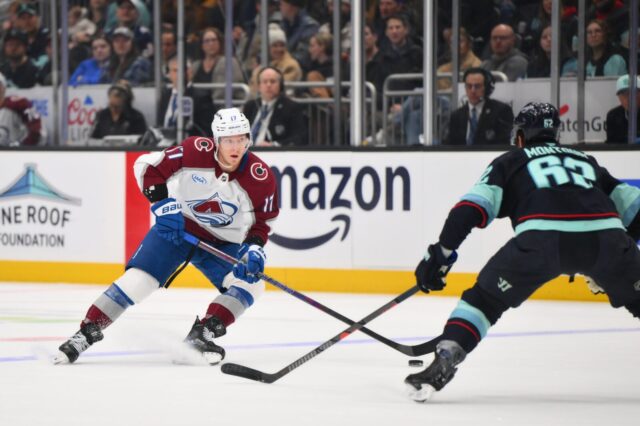Editor’s note: The following story is from the Hockey & Hoops issue of Mile High Sports Magazine.Click here to read the full digital issue.
In 2018-19, UMass-Amherst sophomore defenseman Cale Makar – soon to join the Colorado Avalanche – won the Hobey Baker Award as NCAA hockey’s top player.
In 2019-20, he won the Calder Trophy as the National Hockey League’s rookie of the year. What might that portend? The franchise’s previous winners of the award were Nathan MacKinnon, Gabriel Landeskog, Chris Drury (also a Hobey Baker winner at Boston University) and Peter Forsberg.
“This organization’s been fortunate with some pretty stellar young players,” Makar told me during the Avalanche’s recent training camp. “Obviously, there were some unbelievable years way in the past for this organization. Hopefully, we can bring them back to those days.”
Two of those Calder winners are Makar’s current teammates, a third is in the Hockey Hall of Fame, and the fourth is the recently named general manager of the New York Rangers.
Then, in the COVID-delayed and shortened 2021 season, Makar – swift-skating and an adept playmaker on the back end, and still listed at 5-11 and 187 pounds – was among the finalists for the Norris Trophy, which goes to the league’s top defenseman. The Rangers’ Adam Fox won, and Tampa Bay’s Victor Hedman was the other finalist.
Makar still is only 22. In part, that’s why he can talk about the Avalanche’s glory years as history, not recent events. He was 2 years old the last time Colorado won the Stanley Cup.
(Aside to readers who remember Joe Sakic’s touch pass to Ray Bourque as if it were yesterday: Sorry.)
So what can Makar do for an encore in upcoming 2021-22?
“In my mind, it seems like I haven’t done anything yet or accomplished anything,” he said. “I think a lot of that stems from being successful as a team. I think as a group here, we’re working toward that. As an individual, I’ve been part of a team that has lost in the playoffs in the second round in the last three years. That’s kind of the way I evaluate seasons.
“You want to be at the top of your game individually, but at the same time, being at the top of your game individually comes with when the team is rolling and everybody working together. That’s what I tell everybody, that all individual accolades will come with team success. I think that’s what we strive for on this team. Nobody’s an individual.”
That’s hockey-speak, of course. Pierre Lacroix is smiling as he looks down. That’s hockey, eh? Finish your checks. Give it 110 percent. Couldn’t have done it without the boys. It’s all about the team – from the stingy goaltender standing on his head to the frequently scratched winger who contributes spark, grit and energy. Besides, who knows what’s going to happen to this town after the mill closes? (If you don’t get that, your hockey fan membership card is revoked.)
Hockey players indeed play both the sport and the game.
With that as the qualifying prelude, this is unarguable: Makar is the real deal, whether on the ice or during this September interview.
In two regular seasons with the Avalanche, Makar has 20 goals and 74 assists in 101 games. In three playoff runs, he has 8 goals and 8 assists in 15 games. In late July, he signed a six-year, $54-million contract extension that locks him up through 2026-27. He’s already among the NHL’s top hybrid-type D-men in times when the type has become more coveted than ever. It isn’t checking offensive- or defensive-minded boxes; it’s saluting the strong-skating guys who can be both, to varying degrees.
“I think the way the game’s evolving now, anybody can play D regardless of your size,” Makar said. “I’m not a small guy anymore. I’m 6-feet now. I can hold my own. The prototypical D when I was growing up was definitely big guys who weren’t as mobile as the guys today. They could still play very well. It’s just different. In today’s game, you need guys who can play at both ends of the ice and be that extra threat when you need them to. That’s whether it’s in the offensive zone or breaking out the puck and rushing it through the neutral zone.”
Otherwise, the Calgary-raised son of Laura MacGregor and Gary Makar has a typical hockey backstory.
“Both my mom and my dad played,” Makar said. “Everybody in my family played. My dad’s cousin, Tom Lysiak, was the second overall pick.” (Lysiak split his career between the Atlanta Flames and Chicago.) “Hockey was a big part of our family,” Makar continued, “and my parents instilled that in us at a young age. They probably put a stick in my hands at the age of 1 or 2.”
Makar played his minor (i.e., youth) hockey in the Calgary area, settling in as an undersized –even for his age – defenseman early. He never gave forward a serious or long-term try.
“Any time we had either a guy go down or needed an extra forward, I would always be the first one to play forward,” he said. “I loved it. But I loved being a D-man more. I felt like you were the quarterback of nearly every single play. Everything started with you, whether it was bringing the puck out or in the offensive zone, distributing it from the point. I liked that role on the ice, being in the forefront of everything, being able to control the game at your pace.”
In 2016, Makar committed at age 15 to attend UMass-Amherst – then a bedraggled program – and stuck to it, turning his back on major junior’s Medicine Hat Tigers, who took him in the bantam draft at age 13. Major junior’s stipends would have made him ineligible for NCAA hockey. He attended a couple of the Tigers’ camps, but never seriously considered signing on.
“I was a smaller guy at the time,” he said. “You need those extra years of development to get to where you want to go. I was fortunate I had a cousin who took the college path in Mark Logan, who went to RIT and played for Brooks, too. I started learning about the college path through him, going to seminars with my parents to learn about that route.”
It’s also funny to remember that Makar is here because the Avalanche made the most of what seemed to be a crushingly disappointing NHL draft lottery in April 2017.
Makar still was five months away from enrolling at UMass.
Colorado was coming off the worst bang-for-the-buck season in NHL history, racking up only 48 points while scraping the salary cap ceiling.
With the best chance of landing the top pick in the lottery, the Avalanche had to settle for its worst possible slotting, at fourth overall.
Considering New Jersey and Philadelphia came out of the lottery with the top two picks, beating long odds, it triggered a few wisecracks about, oh, frozen ping-pong balls.
At the subsequent June 2017 draft in Chicago, with Makar attending the proceedings at the United Center, the Avalanche “settled” for the young undersized defenseman coming off two-plus seasons with the Tier II Junior A Brooks Bandits of the Alberta Junior Hockey League.
I’m not saying the pick was a complete shocker. It wasn’t. NHL Central Scouting had Makar rated as the top defenseman among draft-eligible North American skaters. But he also was “only” ninth among North American skaters overall. So it was more case of “Hmmmm…,” than “Who???”
This was two months before coach Patrick Roy, whose preference for big and physical defensemen and his unhappiness with the organization’s lack of recent success drafting at the position both were well-known, abruptly resigned.
The top two picks in that 2017 draft – centers Nico Hischier and Nolan Patrick, who more conventionally came from the major junior ranks – jumped right to the NHL. That’s not unusual in a draft-and-watch sport, but those making that immediate leap generally can be tabulated with fingers on one hand. It was clear from the time the pick was announced that there was no way the Avalanche even considered trying to ask the No. 4 pick to go immediately from Tier II junior hockey to the NHL.
Makar was going to be a college boy – for at least one season, and mostly likely two.
He wasn’t ready and the Avalanche was fine with waiting. He attended the Avalanche’s 2017 and ‘18 development camps before heading to UMass for his freshman and sophomore seasons, providing additional tantalizing hints of what he might become.
That worst-possible, No. 4 draft slotting? It’s fair to say the Avalanche would not have taken Makar with one of the top two picks, and probably not with the third, either.
It worked out, though.
“I’d heard so many things,” Makar said. “I had no idea where I was going to go in the draft. I just remember the experience of that day and I don’t think I could have ended up better than being drafted by the Avalanche.”
Especially because of his Tier II/NCAA path, his progression has been stunningly quick.
In the spring of 2019, Makar had a dreamlike 72-hours. He was awarded the Hobey Baker. He and the no-longer lowly Minutemen came up just short against Minnesota-Duluth in the Frozen Four championship game at Buffalo. He signed a three-year entry level deal with Colorado. He joined the Avalanche in time to score a goal against his hometown Flames in Game 3 of the first-round playoff series at the Pepsi Center.
“It’s a weird feeling playing against the team you grew up loving,” Makar said after the morning skate that day, with both Calgary and Colorado media crowded around him in the Avs’ locker room. “My allegiance is with another team now, so we’ll see how it goes.”
At the time, Makar called the previous few days “pretty crazy. I was supposed to fly out of Buffalo (Sunday), and got rerouted to Toronto. It’s been a long travel day, but I’m rested up.” He joked that Sunday night he “had a really nice bed, the sheets were nice.” He said that he had watched as many Avalanche games as he could during his stay at UMass, “if I wasn’t doing homework at night. I like the way they play, I think they’re very fast, and I think I can fit in really well.”
Looking back on that two years later?
“I basically blacked out the whole weekend,” he said during training camp, smiling. “I just enjoyed the whole process as everything came at me.”
Now he’s going into his third regular season. With an asterisk.
“It’s been a lot of ups and downs, playing-wise,” he said. “I haven’t even played a full season yet in the NHLK, with the COVID year, the bubble, and then a half-season back. It feels weird to know I still have more to give. I feel there’s a lot still to do. For me, it comes down to consistency. It’s making sure that every night, I’m reliable for our team, not just at the offensive end, that they can trust me in all defensive zone situations, too. It’s not something I’ve super-struggled with, but I know it’s tough to maintain that through an entire season.”
Avalanche coach Jared Bednar said he doesn’t expect Makar to level off.
“He’ll take a step,” Bednar said. “Look at all the best D-men in the league. I’ll just go to Hedman. Leads his team in ice time 5-on-5. Leads his team in ice time on the power play. Leads his team in ice time on the penalty kill.”
With that as the standard, Bednar noted that Makar “has got some growing to do with some of the defensive responsibilities, both 5-on-5 and the penalty-kill role.
“There’s no keeping Cale Makar off our penalty kill. He’s going to have to block shots on the flank, he’s going to have to do the job that every other number one D-man does, right? But his upside should lead to a little more ice time. I think his production is going to be a little bit higher. I expect him to have a huge year for us.”
As he continues in the NHL, Makar has remained in touch with the UMass program, and not only as he watched the Minutemen beat St. Cloud State in Pittsburgh to win the 2021 Frozen Four last spring. His younger brother, Taylor, followed Cale’s path from the Brooks Bandits to UMass, and the 6-3 center will be a Minuteman freshman this season. Plus, he was the Avalanche’s seventh round draft choice in July.
“He’s got all the right assets that you need in today’s game,” Cale said of his brother. “He’s an unbelievable skater, has vision and hockey sense. Once he starts filling out his body, he’s going to be a threat to be reckoned with. I’m going to be interested to see how his development goes over college.”
Sound familiar?
Terry Frei is a contributing writer for Mile High Sports Magazine. He is a seven-time winner of a state’s sports writer of the year award in peer voting conducted by the National Sports Media Association — four times in Colorado and three times in Oregon. Among his seven books are novels Olympic Affair and The Witch’s Season; and non-fiction works Horns, Hogs, and Nixon Coming; Third Down and a War to Go; and ‘77: Denver, the Broncos, and a Coming of Age. His web site is www.terryfrei.com



